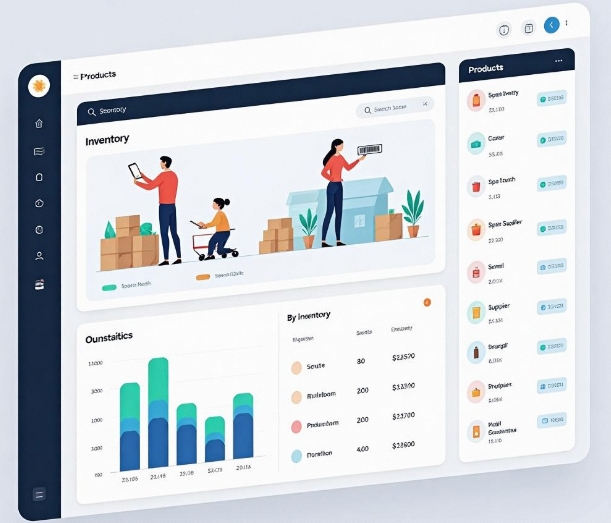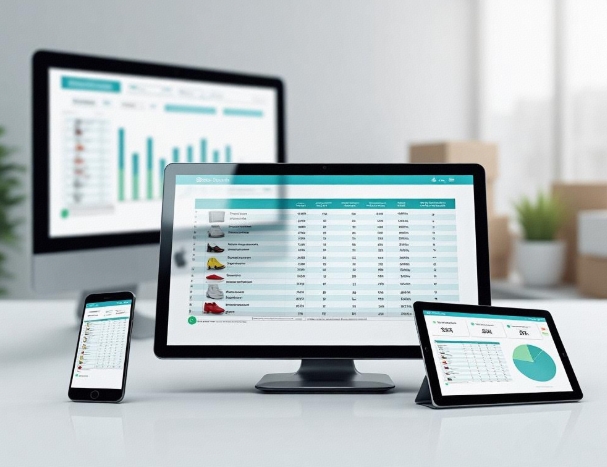Inventory Management and Real-Time Data Synchronization in E-commerce Platform Development
- latest articles
- 1.DApp Development & Customization: Merging Diverse Market Needs with User Experience 2.Analysis of the Core Technical System in DApp Project Development 3.How to achieve cross-chain interoperability in Web3 projects? 4.How does the tokenization of points reconstruct the e-commerce ecosystem? 5.How to Set and Track Data Metrics for a Points Mall? 6.What is DApp Development? Core Concepts and Technical Analysis 7.Inventory of commonly used Web3 development tools and usage tips 8.Development of a Distribution System Integrated with Social E-commerce 9.Six Key Steps for Businesses to Build a Points Mall System 10.What is DApp Development? A Comprehensive Guide from Concept to Implementation
- Popular Articles
- 1.Future Trends and Technology Predictions for APP Development in 2025 2.Analysis of the DeFi Ecosystem: How Developers Can Participate in Decentralized Finance Innovation 3.From Zero to One: How PI Mall Revolutionizes the Traditional E-commerce Model 4.DAPP Development | Best Practices for Professional Customization and Rapid Launch 5.Recommended by the Web3 developer community: the most noteworthy forums and resources 6.From Cloud Computing to Computing Power Leasing: Building a Flexible and Scalable Computing Resource Platform 7.How to Develop a Successful Douyin Mini Program: Technical Architecture and Best Practices 8.Shared Bike System APP: The Convenient Choice in the Era of Smart Travel 9.How to Create a Successful Dating App: From Needs Analysis to User Experience Design 10.From Design to Development: The Complete Process of Bringing an APP Idea to Life
With the rapid development of e-commerce, an increasing number of businesses are turning their attention to the development of online stores. However, during the store development process, inventory management and real-time data synchronization have gradually become core operational challenges for enterprises. Proper inventory management not only helps reduce costs but also enhances the customer shopping experience, while real-time data synchronization is a key factor in ensuring the accuracy, stability, and timeliness of store information.
I. The Importance and Challenges of Inventory Management
Inventory management plays a crucial role in both traditional retail and modern e-commerce. For store development, the purpose of inventory management is to ensure that product stock information is accurate at all times and can be updated in real time. Improper inventory management can lead to a series of issues, such as stockouts, overstocking, or inaccurate product information, which not only affects the operational efficiency of the business but can also result in customer loss and decreased sales.
1. Impact of Stockouts
When stock levels are insufficient, consumers may be unable to purchase their desired products, leading to lost sales opportunities. This situation not only causes direct economic losses but also reduces consumer trust in the store. Over time, the store's reputation will be affected.
2. Issues with Overstocking
Overstocking also poses risks, especially in rapidly changing industries. If inventory accumulates in the warehouse, businesses will have to bear storage costs, risks of product aging, and even unsold goods. Additionally, excess inventory ties up capital flow, affecting the business's cash flow.
3. Data Inaccuracy
Inaccurate inventory data is also a common issue in inventory management. For example, if the system does not promptly update product procurement or sales records, it can lead to incorrect stock quantity displays. Customers may see "phantom inventory," where the product is actually sold out or unavailable for delivery, which undoubtedly greatly diminishes the user experience.
II. Inventory Management Solutions in Store Development
In store development, achieving efficient and accurate inventory management is key to successful business operations. Here are several common inventory management solutions:
1. Implementing Smart Inventory Management Systems
Smart inventory management systems utilize modern information technology, combined with barcodes, RFID, IoT, and other technologies, to help businesses achieve automated inventory management. Through these technologies, businesses can track product flow in real time, automatically update stock quantities, and reduce manual intervention and human errors. For example, barcode scanning systems can automatically update sales information to the backend system by scanning product barcodes, ensuring the accuracy of inventory data.
2. Inventory Alert Systems
An inventory alert system is a predictive management tool based on historical sales data and inventory trend analysis. When stock levels fall below a set threshold, the system automatically issues an alert to remind businesses to replenish stock promptly. This approach helps businesses avoid stockouts and ensures continuous product supply.
3. Multi-Warehouse Management
For large e-commerce platforms, it is often necessary to store products in multiple warehouses across different regions. A multi-warehouse management system helps businesses allocate products rationally to various warehouses and synchronize inventory data in real time. This shortens delivery times, reduces logistics costs, and adjusts product flow between warehouses based on actual demand, thereby improving delivery efficiency.
4. Regular Stocktaking and Automated Reconciliation
Traditional inventory management often relies on manual stocktaking, which is prone to errors. By developing automated stocktaking systems, businesses can periodically verify inventory and automatically generate reconciliation reports. This reduces the cost of manual operations and improves the accuracy of inventory data.
III. The Importance of Real-Time Data Synchronization
As online stores operate, businesses need not only to manage product inventory but also to ensure that various data within the store are synchronized in real time. Real-time data synchronization involves multiple aspects, including product information, order information, inventory changes, and payment information. Delays in any of these areas can reduce the overall operational efficiency of the store and even impact the consumer shopping experience.
1. Order and Inventory Synchronization
In traditional retail models, order and inventory management are handled separately. However, in e-commerce stores, order generation and inventory changes are closely related. If order information and inventory data are not synchronized in time, overselling may occur, leading to stock shortages. To prevent this, store development must achieve real-time synchronization between order data and inventory data.
For example, if a product is purchased in the store, the system should immediately update the product's inventory data and display the real-time stock quantity when other users view the product. If this process is delayed, customers may find that the product they intended to purchase is already sold out, which not only affects the customer experience but may also lead to negative reviews.
2. Cross-Platform Data Synchronization
Today's consumers shop not only through PCs but also via mobile apps, social media platforms, and other channels. Therefore, data synchronization in store development is not limited to synchronization within the same platform but also requires unified management of cross-platform data. Regardless of the platform through which consumers access the store, they should see consistent product information, prices, and inventory data.
Achieving cross-platform data synchronization requires the use of distributed databases and caching technologies to ensure that data updates across different platforms are not constrained by time or space, avoiding information errors caused by data asynchrony.
3. Data Security and Consistency
Another challenge of real-time data synchronization is ensuring data security and consistency. In store development, data involves a large amount of sensitive information, including user details, transaction records, and product inventory. Any data loss or error can have serious consequences. Therefore, store development must implement effective data backup and recovery mechanisms to ensure that data is not lost or corrupted during synchronization.
IV. Technical Implementation of Inventory Management and Data Synchronization
1. Database Design
The database is a core component of store development, and proper database design is crucial for inventory management and real-time data synchronization. Typically, store development combines relational databases (such as MySQL) and non-relational databases (such as Redis) for inventory management. Relational databases primarily store product information, order records, etc., ensuring data integrity, while non-relational databases are used to cache real-time inventory data to improve system response speed and concurrency.
2. Message Queue Technology
Message queue technology can help stores achieve real-time data synchronization. When inventory data changes, the system sends change information via message queues to other related systems (such as the order system, user interface, etc.). Message queues ensure decoupling between various modules in the system and data consistency, while avoiding data inconsistency issues caused by synchronization delays.
3. Distributed Architecture
To meet the operational demands of large-scale stores, many store developments adopt distributed architecture. Distributed architecture effectively distributes system load and improves the efficiency of data synchronization. In this architecture, various service modules operate independently but interact through APIs to ensure real-time data synchronization between modules. This not only enhances system stability but also reduces the risk of single points of failure.
Conclusion
In store development, inventory management and real-time data synchronization are two closely related key aspects. Through smart inventory management systems, multi-warehouse management, alert mechanisms, and other means, businesses can achieve efficient inventory management, reducing the risks of overstocking and stockouts. Meanwhile, with technologies such as message queues and distributed architecture, businesses can ensure real-time synchronization of various data in the store, enhancing the user experience and optimizing operational efficiency. As technology continues to advance, future store development will place greater emphasis on intelligence and real-time capabilities, helping businesses stand out in fierce competition.
-

How does the tokenization of points reconstruct the e-commerce ecosystem?
With the continuous advancement of internet technology and the gradual prolifera···
-

How to Set and Track Data Metrics for a Points Mall?
With the rapid development of the e-commerce industry, points malls, as a common···
-

Development of a Distribution System Integrated with Social E-commerce
With the rapid development of internet technology, the e-commerce industry has e···

 Blockchain
Blockchain












